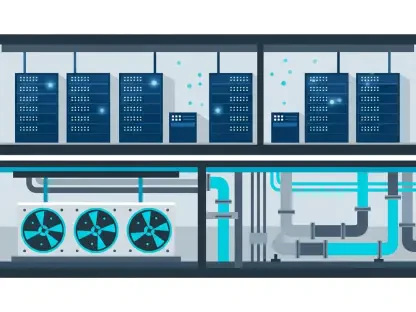In the rapidly evolving landscape of telecom networks, digital twins emerge as a cornerstone innovation transforming operational procedures. This technology transcends traditional methods of network management, which heavily rely on manual audits and hardware-dependent simulations. With the expansion of telecom networks to support increasing devices and services, the risk of configuration errors significantly escalates. Configuration changes are alarmingly attributed to around 80% of network faults. Therefore, digital twin technology offers an advanced solution, promising to mitigate risks and enhance network operation efficiency by dynamically emulating IP networks in real time.
Emulating Network Behavior
Introducing the L4 Catalyst Platform
The L4 Digital Twin Catalyst serves as a transformative platform designed to emulate IP networks dynamically, ensuring maximum service reliability. Traditionally, network operations have been challenged by expanding demands and the risks associated with manual configuration processes. Telecom networks must now accommodate more devices and services, increasing the likelihood of errors, where a single misconfiguration can lead to substantial disruptions. Consequently, embracing digital twins offers a pivotal approach to address these concerns. The platform delivers dynamic emulation capabilities that surpass traditional methods reliant on manual audits and extensive hardware simulations, thus offering a more streamlined and efficient approach to network management.
Addressing Configuration Challenges
Digital twins effectively transform manual configuration tasks for Communication Service Providers (CSPs), minimizing time-consuming processes and potential oversights. Notably, according to TM Forum reports on network automation using machine learning and AI, 43% of CSPs believe that manual processes hinder their operational agility. The adoption of digital twins addresses these challenges by automating and simulating network operation aspects, enabling CSPs to promptly implement advantageous changes with minimal risk. This innovative approach neutralizes risks associated with configuration changes, fostering operational agility and enhancing network reliability. By automating these processes, digital twins empower CSPs to streamline operations and confidently make timely configuration changes, thereby optimizing service delivery without the traditional pitfalls.
Advanced Simulation Technologies
Innovative Design and Functionality
The digital twin platform is underpinned by advanced design methodologies, prominently featuring Huawei’s iMaster NCE Network Digital Map. This platform is equipped with a state-of-the-art CMOS simulation engine, facilitating high-precision modeling without relying on traditional 1:1 hardware laboratory replicas. Traditional network simulators often encounter limitations due to oversimplified network behavior models or the requirement for extensive hardware resources to replicate complete routing states. The digital twin platform effectively bridges this gap, boasting a lightweight design capable of simulating up to 6,000 network elements on a single virtual machine. This novel approach dramatically reduces computational loads by a factor of 1,000 compared to distributed computing simulations, offering highly efficient performance and streamlined resource utilization.
Dynamic Protocol and Traffic Emulation
Among its standout features, the digital twin platform adeptly replicates static network topologies alongside dynamic routing protocols like IGP and BGP and signaling mechanisms such as LDP and RSVP. This advanced capability extends to live traffic flow emulation, allowing CSPs to scrutinize packet movement before and after configuration changes. Such detailed analysis is critical for identifying configuration issues, including policy misconfigurations, unreachable destinations, routing loops, and dangling ACLs. Through this comprehensive emulation, CSPs gain unparalleled insight into network operations, facilitating accurate assessments and informed decision-making. This empowers CSPs to proactively address potential network issues, ensuring optimized configurations and enhanced service delivery.
Operational Optimization and Assurance
Leveraging Advanced Engines for Risk Mitigation
At the core of the platform lies a perception-decision-execution engine, leveraging live network data to simulate the impact of proposed configuration changes. This engine is vital for identifying potential risks, simulating traffic re-routing outcomes, and fostering guided decision-making. In specific scenarios, it even supports automated implementation of safe configurations, significantly reducing simulation tasks from extensive lab environments taking several days to just under ten minutes. This optimization enables CSPs to rapidly process configuration changes, ensuring both efficiency and reliability. The reduction in simulation duration translates to faster response times, empowering CSPs to maintain seamless operations and provide high-quality service.
Aligning with Industry Standards
The platform’s design incorporates guidance from TM Forum, adhering to industry standards for assurance and automation maturity. By integrating assets such as the IP Network Fault Management Questionnaire and the Autonomous Networks Levels Evaluation framework, the system aligns with contemporary telecom operations standards. This commitment to industry best practices ensures robust and reliable network operations, with CSPs benefiting from heightened assurance and automation levels. Adhering to these standards reinforces the platform’s reliability, offering CSPs a best-in-class solution for managing complex network tasks while maintaining alignment with current industry benchmarks.
Real-World Application and Benefits
Case Study: China Mobile Henan Deployment
The deployment of the digital twin platform on China Mobile Henan’s live network presents a compelling case study, highlighting its substantial benefits. Through virtual testing of high-risk migrations and routine network changes, the platform successfully flagged routing anomalies and dangling ACLs, preventing disruptions. This validation instilled confidence among engineers, prompting broader system application across the network. The resulting operational efficiency rose by 94%, with network change faults due to human error decreasing to zero. The average duration for network changes reduced significantly from several days, enabling China Mobile Henan to deliver services more reliably and swiftly. The successful application of digital twins emphasizes their transformative effect, setting new benchmarks for operational excellence within the telecom industry.
Future Prospects and Evolution
In the swiftly transforming arena of telecom networks, digital twins are becoming a pivotal innovation that reshapes how operations are managed. This advanced technology surpasses conventional network management practices, which have traditionally relied heavily on manual audits and simulations dependent on physical hardware. As telecom networks grow to accommodate a rising number of devices and services, the potential for configuration mistakes dramatically increases. Alarmingly, about 80% of network errors are linked to configuration changes. Thus, digital twin technology presents a forward-thinking solution aimed at reducing risks and boosting operational efficiency. By creating dynamic, real-time replicas of IP networks, digital twins enable more precise management and troubleshooting. This enhances the ability to predict and correct issues before they affect the physical network. As a result, telecom companies can maintain service quality and reliability while efficiently managing the complexities associated with a highly interconnected digital landscape.









